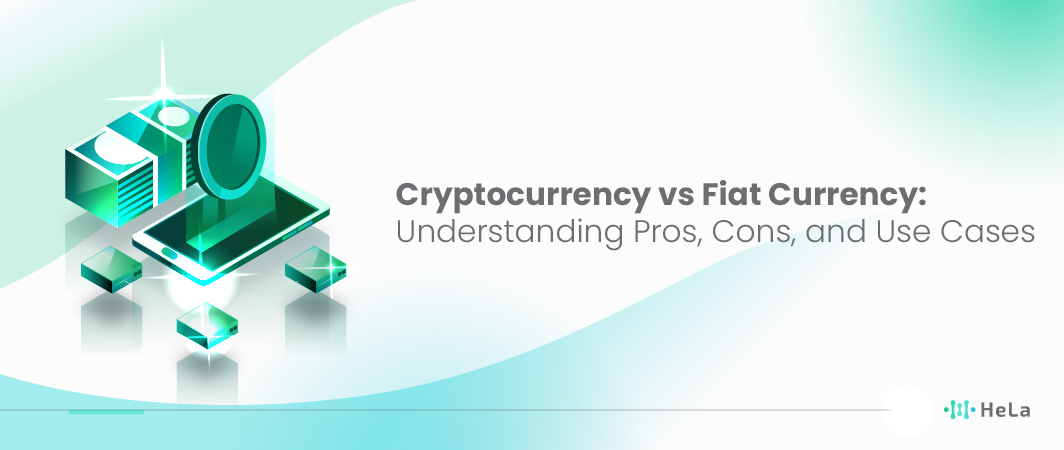Money is a tool. We use it to pay, save, and plan. Yet the form of money is changing. For most of modern life, cash and bank balances ruled. Now digital coins and tokens also claim a place. Many people ask how to think about cryptocurrency vs fiat currency. This guide gives a clear and fair view.
You will see what each kind of money is, how it works, and where it fits. We look at costs, speed, safety, rules, and daily use. We also call out risks in plain words. No hype. No scare. Just facts you can use.
By the end, you will know the core ideas, the key trade-offs, and practical steps. You will be able to choose the right tool for a task, whether that is a cash payment, a bank transfer, or a crypto transfer on a public network.
What Each One Is
This section gives a short view of two kinds of money: fiat currency and cryptocurrency. It explains who issues them and how each works in daily life.
Fiat Currency
Fiat currency is national money made legal by a state. It has value because the law says so and because people trust it. You use fiat every day: pesos, dollars, euros, yen. Central banks issue it. Commercial banks help move it and keep records of balances. Merchants must accept it in most places inside the country.
Fiat value is not tied to gold or other metals. Its supply is managed by a central bank. This bank tries to keep prices stable and jobs strong. When the economy is weak, it may add more money to make credit easier. When prices rise too fast, it may slow the growth of money and raise interest rates.
Fiat lives in many forms. You can hold notes and coins. You can also hold balances in accounts, mobile wallets, and cards. These forms all draw on the same system of central banks, private banks, and payment firms.
Cryptocurrency
Cryptocurrency is digital money that runs on shared networks. No single group owns the ledger. Many computers keep the same record by following rules called a protocol. The network time-stamps each block of transactions and links blocks in a chain. This is why you hear the term “blockchain.”
The most known coins are Bitcoin and Ether. Some coins use a fixed supply. Some use a growing supply with rules baked into the code. Some coins try to track the value of a fiat unit (stablecoins). Users hold coins in software or hardware wallets. You spend by signing a transaction with your private key. The network checks the signature and confirms the change in balances.
Unlike fiat, crypto does not need a bank to send value. Anyone with a wallet and internet can join. This “open access” is a key idea. But it also brings new risks: key loss, scams, and price swings.
How They Work

This section gives a brief look at how each system runs—payment rails, confirmations, key custody, and policy control.
Fiat Rails
Fiat systems use bank accounts, card networks, and clearing houses. If you tap a card, the card network asks your bank to approve. If you wire funds, banks send messages through national or global rails. Transfers can be cheap and fast in one country, and slow or costly across borders. Refunds and chargebacks are common. Rules enforce KYC (know your customer) and AML (anti-money laundering) checks.
Crypto Rails
Crypto systems use a shared ledger. When you send coins, you broadcast a message to the network. Miners or validators group messages into blocks. After a few blocks, your transfer is final and hard to reverse. Costs are “network fees.” These rise and fall with demand. Some chains handle many transactions per second. Others are slower but more secure or more simple.
Keys, Custody, and Recovery
In crypto, the private key controls your funds. Lose it, and the funds may be gone. You can self-custody with a hardware wallet or use a trusted custodian (like a crypto exchange or a specialist wallet firm). In fiat, the bank holds your balance and helps with recovery if you forget a password.
Policy and Control
In fiat, policy comes from the central bank and the state. This affects rates, supply, and rules for banks. In crypto, policy comes from code and community votes. Upgrades need broad support from the network. This makes change slow but also transparent.
Quick Comparison: Cryptocurrency vs Fiat Currency
| Aspect | Cryptocurrency | Fiat Currency |
| Issuer | No central issuer; network protocol | Central bank and government |
| Supply control | Fixed or rule-based in code | Managed by policy and law |
| Backing | Usually none; value from market demand | Backed by state authority and tax power |
| Storage | Software/hardware wallets; custodians | Cash, bank accounts, e-wallets |
| Transfers | Peer-to-peer on a blockchain | Banks, card networks, payment firms |
| Speed | Minutes to seconds (chain-dependent) | Instant to days (rail-dependent) |
| Fees | Network fees; vary with demand | Bank/card fees; often hidden in FX |
| Reversibility | Usually final and hard to reverse | Often reversible (chargebacks, disputes) |
| Privacy | Pseudonymous on public ledgers | Account-based, private by law and policy |
| Volatility | Often high (except stablecoins) | Low to moderate inside one country |
| Access | Open to anyone with internet | May need bank ID; national access varies |
| Legal status | Varies by country | Legal tender in home country |
| Energy use | Depends on chain design | Not linked to a single ledger |
| Typical users | Traders, builders, global payers | Public at large, firms, gov’t |
| Examples | BTC, ETH, stablecoins | USD, EUR, JPY, PHP |
Also Read: How to Launch a Stablecoin? Avoid These Common Mistakes
Pros and Cons

The points below outline the strengths and limits of both forms of money. They show where each system works well and where problems may appear.
Pros of Cryptocurrency
- Open access. You can join without a bank account. You only need a wallet and internet.
- Global by default. You can send value across borders without bank hours.
- Programmable money. Smart contracts allow rules in code: time-locks, split payments, escrow, and more.
- Self-custody. You can hold your own keys and control your funds at all times.
- Transparency. Anyone can check the ledger. You can audit flows in real time.
- Resistance to censorship. If a transaction follows the protocol rules, the network can include it.
- Diverse options. You can pick chains with different trade-offs: cost, speed, security.
Cons of Cryptocurrency
- Price swings. Many coins move a lot in price. This can help traders but hurts stable spending and saving.
- Key loss risk. If you lose your private key and have no backup, you may lose funds.
- Scams and hacks. Fake tokens, phishing, and code bugs can cause loss. You must stay alert.
- Fees and delays at peak times. When demand is high, fees can jump and speed can drop on some chains.
- Learning curve. Wallets, seeds, and gas fees are new ideas for most people.
- Regulatory change. Laws differ by country and can change, which can limit use or access.
Pros of Fiat Currency
- Stable unit in daily life. Prices and wages are set in fiat. This lowers day-to-day risk.
- Wide acceptance. Stores, services, and bills all accept it.
- Consumer protection. Refunds and disputes are standard. Rules protect users from fraud.
- Credit system. Loans, mortgages, and business credit are built on fiat rails.
- Price controls through policy. Central banks can guide rates and respond to shocks.
- Simple recovery. If you forget a password, the bank can help.
Cons of Fiat Currency
- Inflation risk. Over time, the unit may buy less as prices rise.
- Access barriers. Some people cannot open bank accounts or face high fees.
- Cross-border friction. International transfers can be slow and costly.
- Censorship and freezes. Accounts can be frozen due to errors or disputes.
- Limited transparency. Bank ledgers are private; you must trust the institution.
Each system has trade-offs; no single option fits every case. Fiat often suits local, everyday payments due to stability and broad acceptance. Crypto can help with global transfers and programmable features. The practical choice is to match the tool to the need, manage risks, and follow local rules.
Use Cases and When to Choose

You do not have to pick a side. The choice of cryptocurrency vs fiat currency depends on the job at hand. Here are common cases and what tends to work well.
Daily Local Spending
If you buy food, ride transit, or pay a small bill in your town, fiat is often the best tool today. It is accepted by nearly all merchants, and fees are low or hidden. Refunds are simple. In some cities, local payment apps make it instant and cheap.
Global Transfers and Remittances
Sending money across borders is hard with fiat rails. You face high fees, delays, and poor exchange rates. Crypto can help here. A stablecoin transfer can settle in minutes. You can then cash out to local money. The tricky part is the on- and off-ramp. You need a safe and legal way to convert between coins and cash.
Online Work and Micro-Payments
For global freelancers, crypto can be a fast way to get paid. It cuts out long delays and wire fees. For micro-payments, some crypto networks support very small transfers at low cost. This can enable pay-per-article, tips, or other small value flows.
Savings and Hedging
If your local currency loses value fast, you might look for a hedge. Some people use stablecoins tied to a major fiat unit. Others hold Bitcoin or Ether for the long term, hoping the value will rise. This is a personal choice with risk. In stable systems, a good bank account with deposit insurance is often safer and simpler.
Business Operations
Firms plan in fiat. They pay wages, taxes, and suppliers in national money. Some firms also accept crypto from global buyers to reduce card fees and fraud risk. Accounting rules, tax rules, and price swings make pure-crypto operations rare. A split model can work: settle sales in crypto, convert part to fiat at once, and keep a small balance for future on-chain costs.
Aid and Crisis Response
In a crisis, banks may shut down or move slowly. Crypto can move value into a region fast if the internet still works. It can also improve audit trails for donors. But local cash-out can be hard. Planning ahead is key.
Use-Case Fit Matrix
| Use case | Crypto fit | Fiat fit | Notes |
| Daily local shopping | Medium | High | Fiat wins on acceptance and refunds. |
| Cross-border remittance | High | Low–Medium | Crypto can cut cost and time; ramps matter. |
| Online freelance pay | High | Medium | Crypto removes wire delays; taxes still in fiat. |
| Micro-payments | High | Low | Some chains handle tiny transfers well. |
| Long-term savings | Medium | High | Fiat savings accounts are stable; crypto is volatile. |
| Hedge vs local inflation | Medium–High (stablecoins) | Low–Medium | Stablecoins may help if on-/off-ramps are safe. |
| E-commerce with fraud risk | Medium–High | Medium | Crypto is final; fewer chargebacks but no refunds. |
| Donations to crisis zones | Medium–High | Low–Medium | Fast and transparent; cash-out is the hurdle. |
| B2B international settlement | Medium–High | Medium | Crypto can speed netting; compliance is key. |
| Programmable payouts (escrow, splits) | High | Low | Smart contracts shine here. |
Also Read: How Is the Value of Cryptocurrency Determined? A Comprehensive Analysis
Risks, Rules, and Practical Tips
This section outlines key risks, basic rules, and practical steps to use crypto and fiat safely, with clear habits that reduce mistakes and loss.
Price Risk and Unit of Account
We buy and plan in a unit. If that unit swings a lot, planning is hard. This is the main challenge for many coins. A coffee that costs 0.0002 coin today may cost 0.00015 tomorrow. Stablecoins reduce this, but they add trust risk: you must trust the issuer to hold safe assets and to honor redemptions.
Security and Self-Care
In crypto, you are the bank if you hold your own keys. This is powerful but also a duty. Write down your seed phrase on paper and store it in a safe place. Do not take photos of it. Use a hardware wallet for large sums. Check addresses carefully before you send. Start with small test transfers. In fiat, protect your accounts with strong passwords and two-factor login. Watch for phishing in both worlds.
Scams and Safe Habits
Scammers target both fiat and crypto users. In crypto, fake airdrops, fake support chats, and “too good to be true” yields are common tricks. In fiat, fake bank calls and phishing emails are common. Rule of thumb: no real firm will ask for your seed phrase or full card PIN. If someone pressures you to act fast, pause and verify with an official channel.
Regulation and Compliance
Rules differ by country. Some places welcome crypto firms. Others limit or ban them. KYC and AML checks are now common at major exchanges. When you use crypto at scale, expect to show ID and source of funds. For taxes, many places treat crypto like property: trades can create taxable gains or losses. Keep records. In fiat, tax rules are mature and built into most systems.
Environmental Concerns
Some networks once used energy-heavy mining. Many have moved or are moving to designs that use less energy. Not all chains are the same. If this matters to you, pick a chain that aligns with your values.
Practical Tips for Beginners
- Start small. Learn with small amounts you can afford to lose.
- Use known tools. Pick wallets and exchanges with a good track record and clear support.
- Secure your backups. Store seed phrases offline; test recovery before you need it.
- Beware of links. Do not click random links or sign messages you do not understand.
- Plan your ramps. Know how you will convert between coins and cash.
- Track costs. Network fees can change. Check before you send.
- Stay within the law. Learn local rules on crypto use, reporting, and taxes.
- Diversify. Do not keep all funds in one asset or one platform.
- Use stablecoins for pricing. If you must price in crypto, a stable unit helps.
- Think long term. Tools change. Focus on use and safety, not hype.
Conclusion
The debate is not a fight between good and bad. It is a choice between tools. Cryptocurrency vs fiat currency is like email vs postal mail: both move messages, but each is better for some jobs. Crypto gives open access, global reach, and code-based features. Fiat gives stable pricing, wide use, and strong consumer support.
Most people and firms will use both. You might save and spend in fiat, and also hold a small crypto balance for fast global transfers or for new online tools. You might take a payment in a stablecoin, then convert what you need into local cash. A blended approach can give the best of both worlds.
Keep your goals clear. Protect your keys and your accounts. Learn the rules where you live. Start with small steps. As you gain skill, you can add more use cases. With care and patience, you can make smart choices about money in a world that is moving fast.
Disclaimer: The information provided by HeLa Labs in this article is intended for general informational purposes and does not reflect the company’s opinion. It is not intended as investment advice or recommendations. Readers are strongly advised to conduct their own thorough research and consult with a qualified financial advisor before making any financial decisions.

Joshua Soriano
I am a writer specializing in decentralized systems, digital assets, and Web3 innovation. I develop research-driven explainers, case studies, and thought leadership that connect blockchain infrastructure, smart contract design, and tokenization models to real-world outcomes.
My work focuses on translating complex technical concepts into clear, actionable narratives for builders, businesses, and investors, highlighting transparency, security, and operational efficiency. Each piece blends primary-source research, protocol documentation, and practitioner insights to surface what matters for adoption and risk reduction, helping teams make informed decisions with precise, accessible content.
- Joshua Soriano#molongui-disabled-link
- Joshua Soriano#molongui-disabled-link
- Joshua Soriano#molongui-disabled-link
- Joshua Soriano#molongui-disabled-link

